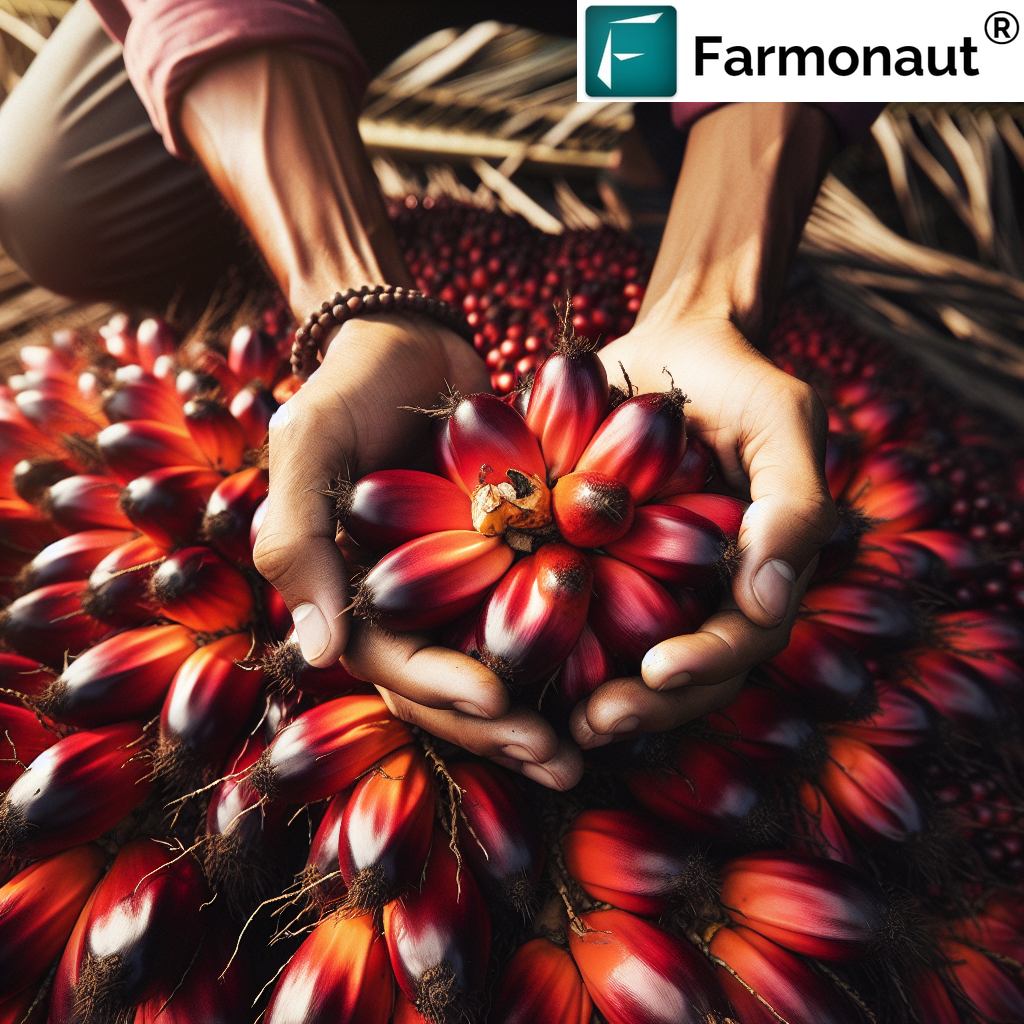Maximizing Profits: A Comprehensive Guide to Oil Palm Farming and Plantation Management in India

In the realm of agriculture, oil palm farming has emerged as a lucrative and sustainable venture, particularly in tropical regions. As we delve into the intricacies of oil palm plantation in India, it’s crucial to understand the potential this crop holds for farmers and the economy at large. At Farmonaut, we’re committed to providing cutting-edge solutions that empower farmers to maximize their yields and profits. In this comprehensive guide, we’ll explore every aspect of oil palm cultivation, from establishing a palm plantation to leveraging advanced technologies for optimal management.
Understanding the Basics of Oil Palm Cultivation
Before we dive into the nuances of palm trees farming, let’s establish a foundation of knowledge about this remarkable crop:
- Oil palm (Elaeis guineensis) is a tropical plant native to West Africa
- It’s prized for its high yield of palm oil, a versatile product used in food, cosmetics, and biofuels
- Oil palms have a productive lifespan of 25-30 years
- They thrive in areas with high rainfall, humidity, and temperatures between 24-32°C
With these basics in mind, let’s explore how to establish and manage a successful palm trees plantation in India.
Establishing an Oil Palm Plantation in India
The journey of oil palm farming begins with careful planning and preparation. Here’s a step-by-step guide to establishing your plantation:
- Site Selection: Choose a location with suitable climate, soil type, and water availability. Coastal regions of Andhra Pradesh, Tamil Nadu, and Kerala are ideal.
- Land Preparation: Clear the land, remove obstacles, and create proper drainage systems.
- Seedling Selection: Opt for high-yielding, disease-resistant varieties from reputable nurseries.
- Planting: Plant seedlings in a triangular pattern, maintaining 9x9x9m spacing for optimal growth.
- Irrigation: Implement an efficient irrigation system to ensure consistent water supply.
At Farmonaut, we understand the importance of precision in these initial stages. Our satellite-based monitoring system can help you assess land suitability and track the progress of your newly established plantation.
Nurturing Your Oil Palm Plantation
Once your palm plantation is established, the focus shifts to nurturing and maintaining the trees for optimal growth and yield:
- Fertilization: Develop a balanced fertilization program based on soil tests and plant requirements.
- Weed Management: Implement integrated weed management practices to reduce competition for nutrients.
- Pest and Disease Control: Monitor regularly for pests like red palm weevil and diseases such as basal stem rot.
- Pruning: Regular pruning of fronds and harvesting of ripe fruit bunches is essential for maintaining tree health and productivity.
Our Jeevn AI Advisory System can provide personalized recommendations for these critical management tasks, ensuring your plantation receives the care it needs to thrive.

Leveraging Technology in Oil Palm Farming
In today’s digital age, technology plays a crucial role in optimizing oil palm farming practices. At Farmonaut, we’re at the forefront of this agricultural revolution, offering a suite of tools designed specifically for palm plantation management:
- Satellite-Based Crop Health Monitoring: Our advanced system provides real-time insights into vegetation health, soil moisture levels, and other critical metrics. This data enables farmers to make informed decisions about irrigation, fertilizer usage, and pest management, ultimately optimizing crop yields and reducing resource wastage.
- AI-Driven Advisory: Our Jeevn AI system analyzes satellite data and other inputs to generate customized advice, improving farm productivity and efficiency.
- Blockchain-Based Traceability: Ensure transparency and build trust in your supply chain with our cutting-edge traceability solutions.
- Fleet and Resource Management: Optimize your plantation operations with our tools for efficient management of vehicles and agricultural machinery.
- Carbon Footprinting: Monitor and reduce your environmental impact with real-time data on emissions, allowing you to take steps towards sustainability.
To experience these revolutionary tools firsthand, visit our app or explore our API services.
The Farmonaut Advantage: Satellite vs. Drone and IoT Monitoring
While drones and IoT devices have their place in agriculture, our satellite-based system offers unique advantages for palm plantation management:
| Feature | Farmonaut Satellite System | Drone-based Monitoring | IoT-based Monitoring |
|---|---|---|---|
| Coverage Area | Entire plantation in one view | Limited by flight time and regulations | Limited by sensor placement |
| Frequency of Data | Regular updates without manual intervention | Depends on flight schedules | Continuous but localized data |
| Cost-effectiveness | High (no hardware investment required) | Moderate (drone purchase and maintenance) | Low to Moderate (sensor costs) |
| Ease of Use | User-friendly interface, accessible anywhere | Requires trained operators | Requires technical setup and maintenance |
| Data Analysis | Advanced AI-driven insights | Often requires separate analysis tools | Limited to sensor capabilities |
Maximizing Profits in Oil Palm Farming
To truly maximize profits in oil palm farming, it’s essential to focus on both increasing yields and optimizing operations:
- Implement Precision Agriculture: Use our satellite-based monitoring to pinpoint areas that need attention, reducing waste and maximizing resource efficiency.
- Optimize Harvesting: Utilize our AI advisory to determine the optimal harvesting times, ensuring maximum oil content in the fruit.
- Diversify Income Streams: Consider intercropping during the early years of plantation establishment to generate additional income.
- Embrace Sustainable Practices: Use our carbon footprinting tools to reduce environmental impact and potentially access premium markets for sustainable palm oil.
- Leverage Data for Decision-Making: Our comprehensive data analytics can help you make informed decisions about every aspect of your plantation management.
By integrating these strategies with our advanced technology solutions, you can significantly boost the profitability of your oil palm plantation in India.
The Future of Oil Palm Farming in India
As we look to the future, the prospects for oil palm farming in India are bright. With the government’s push for domestic palm oil production and advancements in agricultural technology, there’s never been a better time to invest in this sector. At Farmonaut, we’re committed to supporting this growth by continually innovating and improving our services to meet the evolving needs of palm plantation owners.
Some key trends we’re watching include:
- Development of drought-resistant oil palm varieties
- Increased focus on sustainable and organic palm oil production
- Integration of AI and machine learning for even more precise farm management
- Expansion of oil palm cultivation to new regions within India
Stay ahead of these trends by partnering with Farmonaut. Our cutting-edge solutions are designed to adapt to the changing landscape of palm trees farming, ensuring your plantation remains profitable and sustainable for years to come.
Getting Started with Farmonaut
Ready to revolutionize your oil palm plantation management? Here’s how you can get started with Farmonaut:
- Download our app from the Google Play Store or the Apple App Store.
- Sign up for an account and select your plantation area.
- Explore our range of features, from satellite monitoring to AI-driven advisories.
- For developers interested in integrating our services, check out our API documentation.
To subscribe to our services and start transforming your palm trees plantation, use the following payment portal:
Conclusion
As we’ve explored in this comprehensive guide, oil palm farming in India presents a wealth of opportunities for those willing to embrace modern agricultural practices and technologies. By partnering with Farmonaut, you’re not just investing in a crop – you’re investing in a future where precision agriculture, sustainability, and profitability go hand in hand.
From establishing your palm plantation to optimizing every aspect of its management, our suite of tools is designed to support you at every step of your journey. As you embark on or continue your venture in oil palm plantation in India, remember that success lies in the details – and with Farmonaut, those details are always at your fingertips.
Join us in revolutionizing palm trees farming and help shape the future of agriculture in India. Together, we can create thriving, sustainable plantations that benefit farmers, communities, and the environment.
FAQs about Oil Palm Farming and Farmonaut
- Q: How long does it take for oil palms to start producing fruit?
A: Oil palms typically start producing fruit bunches after 3-4 years of planting. However, full production is usually reached around 7-8 years of age. - Q: What are the main challenges in oil palm farming in India?
A: The main challenges include water scarcity in some regions, pest and disease management, and the need for skilled labor for harvesting. Farmonaut’s technologies can help address many of these challenges through precision management and early detection of issues. - Q: How often should I fertilize my oil palm plantation?
A: Fertilization frequency depends on soil conditions and plant age. Generally, young palms require more frequent applications. Our AI advisory system can provide personalized recommendations based on your specific plantation conditions. - Q: Can Farmonaut’s satellite monitoring detect diseases in oil palms?
A: Yes, our advanced satellite imagery can detect changes in vegetation health that may indicate disease or pest infestations, allowing for early intervention. - Q: Is oil palm farming sustainable?
A: When managed properly, oil palm farming can be sustainable. Farmonaut’s tools help farmers implement best practices for resource management and environmental conservation. - Q: How does Farmonaut’s blockchain traceability benefit oil palm farmers?
A: Our blockchain traceability system helps verify the origin and journey of palm oil, potentially opening up premium markets for sustainably produced oil and building trust with consumers. - Q: Can I use Farmonaut’s services for other crops besides oil palm?
A: Absolutely! While this guide focuses on oil palm, our services are applicable to a wide range of crops. The satellite monitoring and AI advisory systems can be tailored to various agricultural needs. - Q: How accurate is satellite-based monitoring compared to ground-level observations?
A: Satellite-based monitoring provides highly accurate data over large areas. While it doesn’t replace ground-level observations entirely, it offers a comprehensive view that’s difficult to achieve through traditional methods alone. - Q: What kind of support does Farmonaut offer to new users?
A: We offer comprehensive onboarding support, including tutorials, customer service, and ongoing technical assistance to ensure you can make the most of our platform. - Q: How often is the satellite data updated?
A: The frequency of updates depends on the subscription plan, but we typically offer updates every 3-5 days, ensuring you have the most current information about your plantation.
We hope this guide has provided valuable insights into the world of oil palm farming and how Farmonaut’s innovative solutions can help you achieve success in your agricultural endeavors. Remember, the future of farming is here, and it’s more accessible than ever with Farmonaut by your side.













